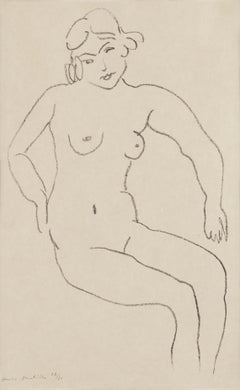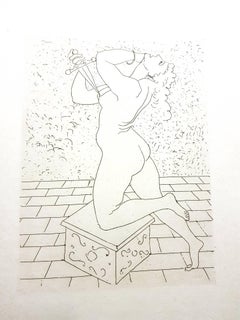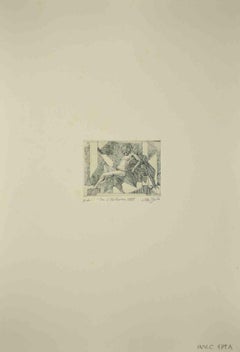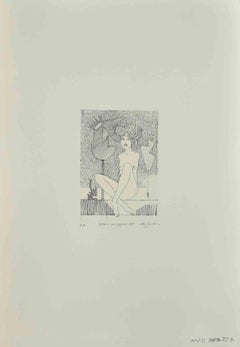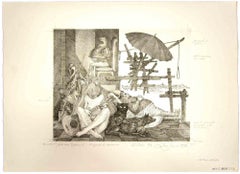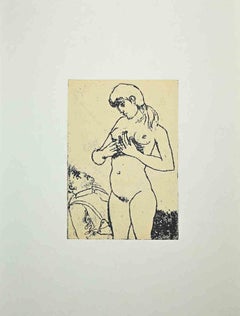Europe - Nude Prints
to
63
518
247
268
42
18
Overall Width
to
Overall Height
to
385
323
95
21
17
15
12
5
4
2
1
1
1
64
43
40
36
35
8
22
823
240
6
35
60
77
29
61
116
244
75
13
8
744
335
13
921
577
512
369
245
236
209
192
142
33
32
30
28
24
23
21
20
19
16
16
380
368
209
60
59
67
397
1,093
1,305
Item Ships From: Europe
Nu assis, chevelure claire
By Henri Matisse
Located in London, GB
Lithograph on Japon paper, Edition of 50
Paper size: 43.7 x 28.1 cms (17.2 x 11.1 ins)
Image size: 39.1 x 23.7 cms (15 3/8 x 9 1/4 ins)
Category
1920s Impressionist Europe - Nude Prints
Materials
Lithograph
André Derain - Ovid's Heroides - Original Etching
By André Derain
Located in Collonge Bellerive, Geneve, CH
André Derain - Ovid's Heroides
Original Etching
Edition of 134
Dimensions: 32 x 25 cm
Ovide [Marcel Prevost], Héroïdes, Paris, Société des Cent-une, 1938...
Category
1930s Modern Europe - Nude Prints
Materials
Etching
Rest - Original Etching by Leo Guida - 1989
By Leo Guida
Located in Roma, IT
With the Ghost is an original etching and aquatint realized by Leo Guida in 1985.
Good condition.
Mounted on a white cardboard passpartout (50x35).
Dated and signed by the author....
Category
1980s Contemporary Europe - Nude Prints
Materials
Etching
Woman with Signals - Original Etching by Leo Guida - 1989
By Leo Guida
Located in Roma, IT
Woman with Signals is an original etching and aquatint realized by Leo Guida in 1989.
Good condition.
Mounted on a white cardboard passpartout (50x35).
Dated and signed by the aut...
Category
1980s Contemporary Europe - Nude Prints
Materials
Etching
Fingono di Dormire - Original Etching by Leo Guida - 1975
By Leo Guida
Located in Roma, IT
Fingono di Dormire is an original Contemporary artwork realized by the italian Contemporary artist Leo Guida (1992 - 2017), in 1975.
Original black and white etching on paper.
Ver...
Category
1970s Contemporary Europe - Nude Prints
Materials
Etching
Nude Woman - Vintage Offset by Franco Gentilini - 1970s
By Franco Gentilini
Located in Roma, IT
Nude Woman is an original vintage offset print on ivory-colored paper, realized by Franco Gentilini ( Italian Painter, 1909-1981), in 1970s.
The state of preservation of the artwor...
Category
1970s Modern Europe - Nude Prints
Materials
Offset
Nude Woman - Vintage Offset by Franco Gentilini - 1970s
By Franco Gentilini
Located in Roma, IT
Nude Woman is an original vintage offset print on ivory-colored paper, realized by Franco Gentilini ( Italian Painter, 1909-1981), in 1970s.
The state of preservation of the artwor...
Category
1970s Modern Europe - Nude Prints
Materials
Offset
Salvador Dali - John Kennedy - Original Handsigned Etching
By Salvador Dalí
Located in Collonge Bellerive, Geneve, CH
Salvador Dali - John Kennedy - Original Handsigned Etching
Dimensions: 38 x 28 cm
1968
Signed in pencil
EA in Sanguine
Jean Schneider, Basel
References : ...
Category
1960s Surrealist Europe - Nude Prints
Materials
Etching
Salvador Dali - The Crown - Original Etching on Silk
By Salvador Dalí
Located in Collonge Bellerive, Geneve, CH
Salvador Dali - The Crown- from "Les Amours de Cassandre"
Original Etching
From the suite on Silk made for editions 9 to 34
Dimensions: 38,5 x ...
Category
1960s Surrealist Europe - Nude Prints
Materials
Etching
Solitude - Etching - Late 20th century
Located in Roma, IT
Solitude is an original etching on ivory-colored paper realized by an unknown artist of the late 20th Century.
Hand-signed on the lower, illegible. Numbered, edition of 20/100 print...
Category
Late 20th Century Modern Europe - Nude Prints
Materials
Etching
Nude of Woman - Zincography by Mino Maccari - 1950s
By Mino Maccari
Located in Roma, IT
Nude of Woman is an original modern artwork realized the 1950s by the Italian artist Mino Maccari (Siena, 1898 - Rome, 1989).
Original zincography on Ivory paper. Image Dimensions: ...
Category
1950s Modern Europe - Nude Prints
Materials
Paper
Nude of Woman - Zincography by Mino Maccari - 1950s
By Mino Maccari
Located in Roma, IT
Nude of Woman is an original modern artwork realized the 1950s by the Italian artist Mino Maccari (Siena, 1898 - Rome, 1989).
Original zincography on Ivory paper. Image Dimensions: ...
Category
1950s Modern Europe - Nude Prints
Materials
Paper
Nude of Woman - Zincography by Mino Maccari - 1950s
By Mino Maccari
Located in Roma, IT
Nude of Woman is an original modern artwork realized the 1950s by the Italian artist Mino Maccari (Siena, 1898 - Rome, 1989).
Original zincography on Ivory paper. Image Dimensions: ...
Category
1950s Modern Europe - Nude Prints
Materials
Paper
Nude of Woman - Zincography by Mino Maccari - 1950s
By Mino Maccari
Located in Roma, IT
Nude of Woman is an original modern artwork realized the 1950s by the Italian artist Mino Maccari (Siena, 1898 - Rome, 1989).
Original zincography on Ivory paper. Image Dimensions: ...
Category
1950s Modern Europe - Nude Prints
Materials
Paper
Nude of Woman - Zincography by Mino Maccari - 1950s
By Mino Maccari
Located in Roma, IT
Nude of Woman is an original modern artwork realized the 1950s by the Italian artist Mino Maccari (Siena, 1898 - Rome, 1989).
Original zincography on Ivory paper. Image Dimensions: ...
Category
1950s Modern Europe - Nude Prints
Materials
Paper
Woman Figure - Original Etching by Edo Janich - 1970s
By Edo Janich
Located in Roma, IT
Woman Figure is an original artwork in etching technique on paper, realized by Edo Janich, in 1970s.
In excellent conditions: as good as new.
Hand-signed ...
Category
1970s Modern Europe - Nude Prints
Materials
Etching
Woman from Shouldes - Original Etching by Giacomo Porzano - 1970s
By Giacomo Porzano
Located in Roma, IT
Woman from Shoulders is an etching on paper, realized by the Italian artist Giacomo Porzano (1925-2006).
In good condition. Image Dimensions: 40 x 50 cm.
This contemporary piece r...
Category
1970s Contemporary Europe - Nude Prints
Materials
Etching
Women and Horses - Original Etching on Paper by Alfredo Brasioli - 1970s
By Alfredo Brasioli
Located in Roma, IT
A Woman and a Horse is a Contemporary artwork realized in the 1970s by the Italian artist Alfredo Brasioli (Verona, 1935 - Rome, 2016).
Original Etching on paper.
Hand-signed in pe...
Category
1970s Modern Europe - Nude Prints
Materials
Etching
Léonard Foujita - The Three Graces - Original Lithograph
By Léonard Tsugouharu Foujita
Located in Collonge Bellerive, Geneve, CH
Léonard Foujita (French/Japanese, 1886–1968)
The Three Graces
Original Lithograph
76 x 54 cm
Signed in the plate
Reference: Sylvie Buisson réf. #60.28 (vol. 1, p.531)
Léonard ...
Category
1960s Modern Europe - Nude Prints
Materials
Lithograph
Nude - Original Etching on Paper by Leo Guida - 1970s
By Leo Guida
Located in Roma, IT
Nude is an original black and white etching realized by Leo Guida.
Not signed.
The state of preservation is good. "INV.C. 72B", on the lower right margin.
Leo Guida: Artist sensi...
Category
1970s Modern Europe - Nude Prints
Materials
Etching
Nude - Etching on Paper by Leo Guida - 1970s
By Leo Guida
Located in Roma, IT
Nude is an original black and white etching realized by Leo Guida.
Hand-signed and dated in pencil, on the lower right. "Prova D'Autore", on the lower left.
The state of preservat...
Category
1970s Modern Europe - Nude Prints
Materials
Etching
Nude - Original Etching by Sergio Barletta - 20th Century
By Sergio Barletta
Located in Roma, IT
Nude is an original etching on cardboard realized by Sergio Barletta.
Hand-signed on the lower right in pencil. Titled in Italian on the lower left "Morta di Stampa".
In very good ...
Category
20th Century Contemporary Europe - Nude Prints
Materials
Etching
Oriental Nude - Lithograph on Paper by Maurice Barraud - 1929
Located in Roma, IT
Oriental Nude is original lithograph on paper realized in 1929 by Maurice Barraud.
Signed on the plate on the lower left.
The state of preservation i...
Category
1920s Europe - Nude Prints
Materials
Lithograph
The Human Comedy - Lithograph
By (after) Pablo Picasso
Located in Collonge Bellerive, Geneve, CH
After Pablo Picasso
The Human Comedy - Lithograph after an original drawing, as published in the journal "Verve"
Printed signature and date Dimensio...
Category
1950s Modern Europe - Nude Prints
Materials
Lithograph
Nude - Etching by Sergio Barletta - 1980
By Sergio Barletta
Located in Roma, IT
Nude is an original etching realized by Sergio Barletta in 1980.
Hand-signed on the lower right in pencil. Numbered, edition of 37/50 prints, on the lower left in pencil.
In very g...
Category
1980s Contemporary Europe - Nude Prints
Materials
Etching
Nude - Vintage Offset Print by Franco Gentilini - 20th Century
By Franco Gentilini
Located in Roma, IT
Nude is an original Vintage Offset Print on ivory-colored paper, realized by Franco Gentilini (Italian Painter, 1909-1981) in the late 20th Century.
The state of preservation of the...
Category
20th Century Europe - Nude Prints
Materials
Offset
Nude - Etching by Sergio Barletta - 1970s
By Sergio Barletta
Located in Roma, IT
Nude is an original lithograph artwork, realized by Sergio Barletta, hand-signed, edition of 5/100.
In very good conditions.
Here the artwork represents a different pose of nudes,...
Category
1970s Europe - Nude Prints
Materials
Etching
Cover for "Il Tirreno" - Watercolor by Mino Maccari - 1960s
By Mino Maccari
Located in Roma, IT
Original artwork realized by Mino Maccari in the 1960s.
Mixed colored watercolor drawing on cardboard realized for the newspaper "Il Tirreno".
Hand-signed by the artist on the lowe...
Category
1960s Modern Europe - Nude Prints
Materials
Watercolor
Nude Study - Original Drawing in Charcoal by Debora Sinibaldi - 1985
By Debora Sinibaldi
Located in Roma, IT
Nude Study is an original drawing in brownish charcoal on ivory paper, realized by Debora Sinibaldi in 1985.
In good condition with some folding along the margins.
The artwork repr...
Category
1980s Europe - Nude Prints
Materials
Charcoal
The Painter and the Model - Etching by Giacomo Manzù - 1930s
By Giacomo Manzú
Located in Roma, IT
The painter and the model is an original rare etching on paper realized by the Italian artist Giacomo Manzù.
Hand-signed on the lower right and numbered only edition of 17 prints.
...
Category
1930s Europe - Nude Prints
Materials
Etching
The Rounder Pop Art Mel Ramos Nude Boxing Print Lithograph blue
By Mel Ramos
Located in Zug, CH
MEL RAMOS (1935-2018)
The Rounder
1999
Lithograph
92.1 x 48.9 cm
36.26 x 19.25 inches
Edition of 199 with HC 20
Edition HC 12/20
Signed and numbered in pencil
Category
20th Century Europe - Nude Prints
Materials
Lithograph
Nude - 6 - Lithograph by Carlo Marcantonio - 1970
By Carlo Marcantonio
Located in Roma, IT
Hand Signed. Edition of 50 pieces plus 15 Artist's Proofs in Roman Numbers.
Category
1970s Contemporary Europe - Nude Prints
Materials
Lithograph
"Peak of the Moment 2" Photography 31.5" x 24" inch Edition of 5 by Lukas Dvorak
By Lukas Dvorak
Located in Culver City, CA
"Peak of the Moment 2" Photography 31.5" x 24" inch Edition of 5 by Lukas Dvorak
Pigment print on Epson Fine ART paper
2023
Ships rolled in a tube
ABOUT THE ARTIST
Lukas Dvorak i...
Category
21st Century and Contemporary Contemporary Europe - Nude Prints
Materials
Archival Paper, Pigment
Salvador Dali - Venus, Mars and Cupidon - Handsigned Etching
By Salvador Dalí
Located in Collonge Bellerive, Geneve, CH
Salvador Dali - Venus, Mars and Cupidon - Handsigned Etching
Title: Venus, Mars and Cupidon
Dimensions: 76 X 56 cm
From the Homage to Dürer
Numbered: EA, Epreuve d'Artiste
Rives ...
Category
1970s Surrealist Europe - Nude Prints
Materials
Etching
Untitled Plate 10 from Paroles Peintes Suite - 1970s - Sebastián Matta
By Sebastian Matta
Located in Roma, IT
Untitled Plate 10 from Paroles Peintes Suite is an etching and aquatint on Japon paper.
Hand-signed and hand-numbered in pencil on the lower margin. Edition of 85 prints.
Perfect co...
Category
1970s Contemporary Europe - Nude Prints
Materials
Etching, Aquatint
Untitled Plate 9 from Paroles Peintes Suite - 1970s - Sebastián Matta
By Sebastian Matta
Located in Roma, IT
Untitled Plate 9 from Paroles Peintes Suite is an etching and aquatint on Japon paper. Hand-signed and hand-numbered in pencil on the lower margin. Edition of 85 prints.
Perfect con...
Category
1970s Contemporary Europe - Nude Prints
Materials
Etching, Aquatint
Untitled Plate 5 from Paroles Peintes Suite - 1970s - Sebastián Matta
By Sebastian Matta
Located in Roma, IT
Untitled Plate 5 from the Paroles Peintes Suite is an etching with aquatint on Japon paper. Hand-signed in pencil on the lower right; numbered on the lower left in pencil. Edition of...
Category
1970s Contemporary Europe - Nude Prints
Materials
Etching, Aquatint
Untitled Plate 2 from Paroles Peintes Suite - 1970s - Sebastián Matta
By Sebastian Matta
Located in Roma, IT
Untitled Plate 2 from Paroles Peintes Suite is a wonderful limited edition print.
Etching with aquatint on Japon paper. Hand-signed in pencil on the lower right; numbered on the lowe...
Category
1970s Contemporary Europe - Nude Prints
Materials
Etching, Aquatint
Bert Stern - Silkscreen The last session - Red
By Bert Stern
Located in Saint Ouen, FR
Bert Stern - Silkscreen The last session - RED
Large screen print in a single run which was used as a proof for the No2 issue of the US Avant Garde magazine in August 1968.
Signed ...
Category
1960s Europe - Nude Prints
Materials
Paper
The Human Comedy - Lithograph
By (after) Pablo Picasso
Located in Collonge Bellerive, Geneve, CH
after Pablo Picasso - The Human Comedy - Lithograph
Signed and dated in the plate
Dimensions: 32 x 24 cm
This artwork is a lithograph in colors on wove paper after a drawing by Pablo...
Category
1950s Modern Europe - Nude Prints
Materials
Lithograph
The Human Comedy - Lithograph
By (after) Pablo Picasso
Located in Collonge Bellerive, Geneve, CH
After Pablo Picasso
The Human Comedy - Lithograph after an original drawing, as published in the journal "Verve"
Printed signature and date
Dimensions: 32...
Category
1950s Modern Europe - Nude Prints
Materials
Lithograph
Roger Chapelain-Midy - Original Handsigned Lithograph - Ecole de Paris
By Roger Chapelain Midy
Located in Collonge Bellerive, Geneve, CH
Roger Chapelain-Midy
Original Handsigned Lithograph
Dimensions: 76 x 54 cm
Edition: HC XXI/XXX
HandSigned and Numbered
Ecole de Paris au seuil de la mutation des Arts
Sentiers Editi...
Category
1970s Modern Europe - Nude Prints
Materials
Lithograph
Leonor Fini - Fearless - Original Handsigned Lithograph
By Leonor Fini
Located in Collonge Bellerive, Geneve, CH
Leonor Fini - Fearless - Original Handsigned Lithograph
Les Elus de la Nuit
1986
Conditions: excellent
Handsigned and Numbered
Edition: 230
Dimensions: 38 x 28 cm
Editions: Trinckve...
Category
1980s Modern Europe - Nude Prints
Materials
Lithograph
After Alexander Calder (1898-1976) - 20th Century Lithograph, Three Legged Man
Located in Corsham, GB
Presented in a simple white mount. Unsigned. On paper.
Category
20th Century Europe - Nude Prints
Materials
Lithograph
$300 Sale Price
20% Off
Salvador Dali - Pierre Curie - Original Handsigned Engraving
By Salvador Dalí
Located in Collonge Bellerive, Geneve, CH
Salvador Dali - Pierre Curie - Original Handsigned Engraving
Dimensions: 17.5 x 12.5 cm
1970
Signed in pencil
EA
Jean Schneider, Basel
References : Field 70-5
Provenance : Schneider ...
Category
1960s Surrealist Europe - Nude Prints
Materials
Engraving
"I Met a Girl Wearing Hats" Photography Edition 2/7 32"x24" in by Lukas Dvorak
By Lukas Dvorak
Located in Culver City, CA
"I Met a Girl Wearing Hats" Photography Edition 2/7 32"x24" in by Lukas Dvorak
Pigment print on Epson Fine ART paper
2021
Unframed
Ships rolled in a tube
ABOUT THE ARTIST
Lukas...
Category
21st Century and Contemporary Contemporary Europe - Nude Prints
Materials
Archival Paper, Pigment
Marc Chagall - Woman Angel - Original Lithograph
By Marc Chagall
Located in Collonge Bellerive, Geneve, CH
Marc Chagall, Original Lithograph depicting an instant of the Bible.
Technique: Original lithograph in colours
Year: 1956
Sizes: 35,5 x 26 cm / 14" x 10.2" (sheet)
Published by: Édit...
Category
1950s Modern Europe - Nude Prints
Materials
Lithograph
"Garden of Ethernity 3" Photography 24" x 31.5" inch Ed. of 5 by Lukas Dvorak
By Lukas Dvorak
Located in Culver City, CA
"Garden of Ethernity 3" Photography 24" x 31.5" inch Ed. of 5 by Lukas Dvorak
Pigment print on Epson Fine ART paper
2023
Ships rolled in a tube
ABOUT THE ARTIST
Lukas Dvorak is ...
Category
21st Century and Contemporary Contemporary Europe - Nude Prints
Materials
Archival Paper, Pigment
André Derain - Ovid's Heroides - Original Etching
By André Derain
Located in Collonge Bellerive, Geneve, CH
André Derain - Ovid's Heroides
Original Etching
Edition of 134
Dimensions: 32 x 25 cm
Ovide [Marcel Prevost], Héroïdes, Paris, Société des Cent-une, 1938
Andre Derain was born in 1880 in Chatou, an artist colony outside Paris. In 1898, he enrolled in the Academie Carriere in Paris where he met Matisse. He attended art school and in 1900, set up a studio with Maurice deVlaminck. After his military service from 1900-1904, Derain exhibited his work at the Salon des Independants and then at the Salon d'Automne with Matisse, Vlaminck and others, thus creating the movement of Fauvism.He worked with Henri Matisse in 1905 at Collioure, and participated in the 1905 Salon d’Automne with Matisse, Vlaminck, and Braque, the exhibition in which this group was labeled as Fauves, or Wild Beasts. Along with Vlaminck, Derain was one of the first artists to collect the tribal art of Africa which was influential to many of the artists of the early 20th century.
In 1906, Derain met Picasso and his dealer, who purchased Derain's entire studio, creating newfound financial success. During this time, he was hired for the illustrations for works by Guillaume Apollinaire and Andre Breton. After World War I, his friend's Cubism movement affected his art, along with influence from Classicism and African Art.
Derain stayed in Paris during most of the Occupation, where he was esteemed by the Nazis because of his artistic integrity. Hitler's Foreign Minister commissioned him to paint a family portrait, but he politely refused. His popularity began to decline after the war because of disagreement over new artistic movements. He later lost most of his eyesight due to illness, which may have been the reason he was hit by a truck in 1954, dying from shock at the age of 74.
Derain’s Fauve paintings are typically bright with intense color. Influenced by the work of Cézanne as well as the early Cubist paintings of Picasso and Braque’s, Derain’s style changed and by 1912, the paintings became more traditional and structured. For the remainder of his career, he continued to investigate different compositional methods including the perspective of Cézanne and the pointillism of Seurat. He also designed ballet sets and made a number of sculptures.
At the turn of the century, Andre Derain exhibited at the radical Fauve Salon d’Automne (1905) and was one of the founding members of the Fauvist movement together with his life-long friends Matisse and Vlaminck. The works he produced in this period, often under the guidance of Matisse, have been counted among the masterpieces of Fauvism.
From around 1918, Derain turned his back on the avant-garde and had begun to explore some of the more traditional genres of Western art, including landscapes. His main source of inspiration once the Fauves group had dispersed was found in the Louvre, where he admired the early Renaissance works in particular. Talking of his frequent visits there, he once said, ‘That seemed to me then, the true, pure absolute painting.’ His work evolved through many styles and, most significantly, turned back to the past, particularly after 1922 when Lenin had publicly pronounced his disdain for abstract art.
Derain built up an immense and fascinating collection of paintings, sculpture and objets d’art throughout his life which aided his experimentation and was reflected in his work between 1930 and 1945. During these years, his painting technique displayed the most avenues of invention, using a repertoire of primitivist motifs. His eclectic collection was constantly changing. In 1930 he sold his African collection in exchange for bronzes of antiquity and the Renaissance which indicated a real change of interest in the objects, as did his later pursuit of Greek ceramic painting and his enthusiasm for grand cycles of literary and antique themes...
Category
1930s Modern Europe - Nude Prints
Materials
Etching
Alfons Mucha - Original Lithograph - Christmas Baby Party
By Alphonse Mucha
Located in Collonge Bellerive, Geneve, CH
Title: Decorative Documents
Author: Alfons Mucha.
Publisher: Paris: Librairie Centrale des Beaux-Arts, 13 Rue Lafayette. Emile Levy publisher. Published ...
Category
Early 1900s Art Nouveau Europe - Nude Prints
Materials
Lithograph
Salvador Dali - Moshe Dayan - Original Handsigned Etching
By Salvador Dalí
Located in Collonge Bellerive, Geneve, CH
Salvador Dali - Moshe Dayan - Original Handsigned Etching
Dimensions: 38 x 28 cm
1968
Signed in pencil
EA in Sanguine
Jean Schneider, Basel
References : Fi...
Category
1960s Surrealist Europe - Nude Prints
Materials
Etching
Salvador Dali - Nude at the Fountain
By Salvador Dalí
Located in Collonge Bellerive, Geneve, CH
Salvador Dali - Nude at the Fountain - Original Etching
Dimensions: 38 x 28 cm
Edition: 235
1967
embossed signature
On Arches Vellum
References : Field 67-10 (p. 34-35)
Category
1960s Surrealist Europe - Nude Prints
Materials
Etching
Leonor Fini - Road to Death - Original Lithograph
By Leonor Fini
Located in Collonge Bellerive, Geneve, CH
Leonor Fini - Road to Death - Original Lithograph
The Flowers of Evil
1964
Conditions: excellent
Edition: 500
Dimensions: 46 x 34 cm
Editions: Le Cercle du Livre Précieux, Paris
Un...
Category
1960s Modern Europe - Nude Prints
Materials
Lithograph
Alfons Mucha - Original Lithograph - Femmes Art Nouveau
By Alphonse Mucha
Located in Collonge Bellerive, Geneve, CH
Title: Decorative Documents
Author: Alfons Mucha.
Publisher: Paris: Librairie Centrale des Beaux-Arts, 13 Rue Lafayette. Emile Levy publisher. Published ...
Category
Early 1900s Art Nouveau Europe - Nude Prints
Materials
Lithograph
"Tatoue" eglomise from the famous "Sensuality" Series by Vladimir Clavijo
By Vladimir Clavijo-Telepnev
Located in Palm Beach, FL
In this project, Vladimir Clavijo-Telepnev draws a line between sensuality and explicit sexuality in depicting a woman's body. Modern photography offers two main approaches to the su...
Category
Early 2000s Romantic Europe - Nude Prints
Materials
Gold Leaf
Jacques Villon - Sleeping Nude - Original Etching
By Jacques Villon
Located in Collonge Bellerive, Geneve, CH
Jacques Villon - Sleeping Nude - Original Etching
Circa 1950
Signed in pencil
Edition of 45.
Dimensions : 32.7 x 25 cm
Category
1950s Modern Europe - Nude Prints
Materials
Etching
Salvador Dali - Head of Veal - Original Etching
By Salvador Dalí
Located in Collonge Bellerive, Geneve, CH
Salvador Dali - Head of Veal - Original Etching
Embossed signature
From the edition of 731
Dimensions: 38,5 x 28,5 cm
1969
References : Field 69-1 / Michler & Lopsinger 305
Category
1960s Surrealist Europe - Nude Prints
Materials
Etching
"Monte Clerigo" Photography 31.5" x 24" inch Edition 1/5 by Lukas Dvorak
By Lukas Dvorak
Located in Culver City, CA
"Monte Clerigo" Photography 31.5" x 24" inch Edition 1/5 by Lukas Dvorak
Pigment print on Epson Fine ART paper
2016
Ships rolled in a tube
ABOUT THE ARTIST
Lukas Dvorak is a Cz...
Category
21st Century and Contemporary Contemporary Europe - Nude Prints
Materials
Archival Paper, Pigment
Pablo Picasso (after) Helene Chez Archimede - Wood Engraving
By (after) Pablo Picasso
Located in Collonge Bellerive, Geneve, CH
Pablo Picasso (after)
Helene Chez Archimede
Medium: engraved on wood by Georges Aubert
Dimensions: 44 x 33 cm
Portfolio: Helen Chez Archimede
Year: 1955
Edition: 240 (Here it is on...
Category
1950s Cubist Europe - Nude Prints
Materials
Engraving, Woodcut
André Masson - Original Lithograph
By André Masson
Located in Collonge Bellerive, Geneve, CH
Maurice Estève - Composition
Original Lithograph
1964
Dimensions: 32 x 25 cm
Revue XXe Siècle
Cahiers d'art published under the direction of G. di San Lazzaro.
French painter born...
Category
1960s Abstract Expressionist Europe - Nude Prints
Materials
Lithograph
